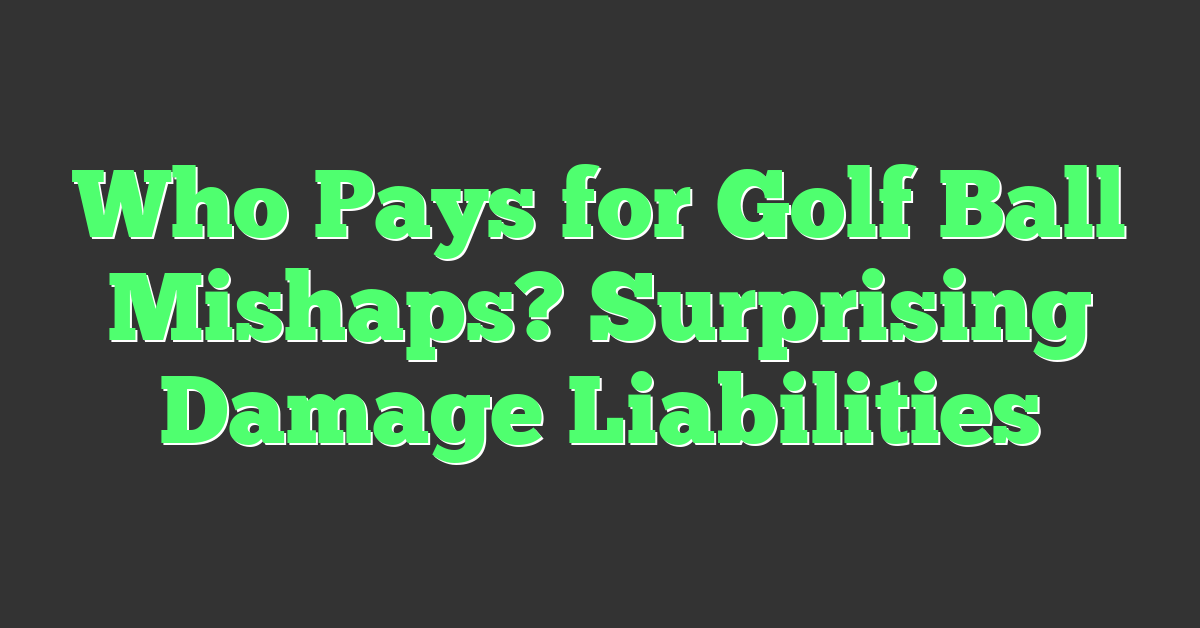Ever found yourself in the middle of a peaceful golf game, only to hear the dreaded sound of a golf ball smashing into something it shouldn’t? It’s not just your scorecard that takes a hit when that happens. The question of who’s on the hook for the damage can be as tricky as a bunker shot.

Whether you’re the one taking the swing or the unfortunate victim of a wayward ball, knowing the ins and outs of responsibility on the golf course is crucial. You’ll want to read on to ensure your knowledge is up to par—because in the world of golf, it’s not just about playing the game, it’s also about playing it smart.
Responsibilities of the Golfer
As a seasoned golfer, you’re well-aware that every swing comes with its potential hazards. You’re on the fairway, not just to enjoy the game but also to uphold the integrity and responsibilities that come with it. When out on the course, your first responsibility is ensuring the safety of others. Always shout “Fore!” the moment you realize your ball might pose a risk to another player or spectator. It’s not just about common courtesy but a non-negotiable aspect of the game.
Besides the verbal warning, there are a few other standards you’re expected to adhere to:
- Check your surroundings: Before you take a swing, glance around for people or property that your ball could potentially harm.
- Control your shots: Work on your accuracy and precision. While no one’s perfect, consistently practicing your swing will minimize mishaps.
- Acknowledge your mishits: When a ball goes astray and causes damage, it’s your duty to step up immediately and address the situation.
Keep in mind, your responsibilities don’t end there. You’re also expected to understand and respect the course rules. These dictate what you should do if your golf ball damages something such as another golfer’s equipment or a nearby vehicle. In most cases, you may find that the rules hold you liable for any damages caused by your errant shots.
When it comes to property damage, the situation can get a bit tricky. If your ball veers off and breaks a window of a home adjacent to the course, for instance, it’s typically considered an act of God. However, this doesn’t absolve you from the responsibility of the aftermath. Ensure you’re familiar with the local laws and golf course policies as these can differ from place to place.
Remember, part of improving your game is about managing risks. As you continue to work on striking that ball just right, always keep safety and responsibility in mind. That’s the hallmark of not just a good golfer, but a great one.
Responsibilities of the Golf Course
As a seasoned golfer, you’re likely well aware that not all the responsibility falls on you. Golf courses also carry an essential role in ensuring players and their surroundings are safeguarded. As you strive to improve your game and lower your scores, it’s also important to understand how golf courses are designed to minimize the risks of stray shots.
Course Design: One key aspect is the thoughtful design of the course. This involves the strategic placement of hazards, greens, and fairways to reduce the likelihood of injury or damage. Golf course architects aim to create challenging yet safe layouts. Think about the bunkers, trees, and water bodies that are not just there to test your skills but also to absorb or deflect errant shots.
Warning Signage: Golf courses must also display signs at appropriate places to warn both players and the public of potential dangers. These signs can include messages about incoming golf balls and direct people to safe paths around the course. As you navigate the course, you’ll often see these precautions in the form of:
- “Fore” warnings
- Directions for cart paths
- Out-of-bounds markers
Maintenance: Regular maintenance is another vital part of a golf course’s responsibilities. Properly maintained fairways and rough can help control the roll of golf balls, potentially stopping them before causing harm or damage. Think about how well-kept rough has often saved you from overshooting the green.
Course Policies: Furthermore, golf courses implement specific policies to protect both players and their property. This ranges from golf cart usage, speed limits to rules about playing specific holes when weather conditions might increase the risk of accidents. These policies are there to help ensure everyone’s safety, so it’s important that you’re familiar with them.
While the golf course does its part to provide a safe environment, remember that you’re an active participant in this shared space. Maintaining awareness on the course goes hand-in-hand with honing your skills. So as you aim to master the game and achieve those lower scores, consider the course’s role in the bigger picture of golfing safety.
Liability for Damages
As a seasoned golfer, you know the feeling of watching a ball sail off course—it’s part of the game. But when your ball damages property or injures someone, it’s crucial to understand who’s held responsible. In the realm of golf, the liability for damages often falls squarely on the golfer who struck the ill-fated shot.
You’re expected to hit stray shots now and then; it’s a natural consequence of the game’s challenges. However, if your shot ends up breaking a window or denting a car, you might be on the hook for the damages. Golf courses usually have disclaimers and signs stating that they are not responsible for damages caused by errant balls, shifting the responsibility to the players.
Your liability doesn’t end with property damage; it extends to personal injury as well. If your ball hits someone on or off the course, you could face serious consequences. This area of the law, known as tort law, is based on negligence. Proving who’s liable in these situations rests on the concept of ‘foreseeability’. It’s about what a reasonable person would anticipate as a potential outcome of their actions.
In legal terms, if hitting into a group of golfers ahead without warning is an action a reasonable person would see as having the potential to cause harm, then it’s foreseeable—it’s negligent. And negligence could make you liable. Here’s a quick rundown of what factors are typically considered when determining liability for a stray shot:
- Proximity to the hazard: Are you hitting near homes or populated areas?
- Adequate warning: Did you yell ‘fore’ or take measures to warn others?
- The behavior of the injured party: Were they aware of the risk and acting safely?
Remember, homeowners and insurance companies may pursue claims against golfers, so having appropriate insurance that covers golf-related accidents can be a valuable safeguard.
Golf is a sport of precision and etiquette. Being aware of your surroundings and playing responsibly not only helps you avoid unwanted liability but also sets a standard for safety and respectability on the course. Always be aware of the potential risks and act in a way that protects both yourself and others around you.
Golf Course Insurance Policies
When you’re out there swinging clubs, the risk of a stray ball causing damage always looms. Golf course insurance policies, while not directly safeguarding your pocket from claims, play a pivotal role for golf courses in mitigating risks. Most courses are covered under a general liability policy designed to protect the establishment against lawsuits resulting from injuries or damages occurring on their property.

What does this mean for you as a golfer? While the course’s insurance may cover incidents like a slip and fall in the clubhouse, it often doesn’t extend to damage caused by your errant shots. You’re out there under the open sky, away from the confines of nets and walls; this freedom also means bearing the brunt of liability yourself.
Here are some key elements courses typically cover under their insurance:
- Property damage: to course infrastructure caused by weather or vandalism
- Bodily injury: incidents to patrons not involving golf play
- Business operations: such as food and beverage services
You might be wondering where that leaves you if your ball dents a car parked outside the course boundary or shatters a window of a neighboring home. The answer lies in your personal coverage. It’s worth checking in with your homeowners or renter’s insurance policy to see what golf-related incidents might be covered. Often, personal liability insurance can include coverage for damages caused by sports activities, including golf.
If you’re traveling and playing, consider traveler’s insurance that covers sports activities. Some policies provide additional coverage for incidents that occur away from home, including international golf escapades—because mishaps don’t take a vacation just because you do.
Understanding the ins and outs of insurance isn’t just about knowing what’s covered—it’s about protecting your game and those around you. Always ensure you’re well-informed about the coverage you have before teeing off. Keep sharpening your skills; responsible play reduces the chances of accidents, but it’s wise to be prepared for that occasional wayward shot.

Conclusion
Navigating the fairways of liability can be as tricky as a tight dogleg left. Remember, when you’re out on the green, you’re not just playing against the course, but also against the potential for mishaps that could lead to damage. It’s essential to know where you stand with your insurance before you tee off. Don’t let an unexpected slice turn into a financial burden; ensure your coverage is up to par. So next time you grab your clubs, take a moment to consider your responsibility off the tee. Play smart and stay informed—it’s the best way to enjoy the game and protect yourself, all in one swing.










